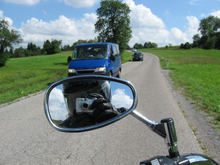 Every biker has a pile of these pictures. “Here’s my bike in Sturgis…. Here’s my bike in front of Mt. St. Helens… Here’s my bike in front of my family…” If you’re going to take pictures of your bike (you know you are), here are a few tips to help make your motorcycle photographs even better.
Every biker has a pile of these pictures. “Here’s my bike in Sturgis…. Here’s my bike in front of Mt. St. Helens… Here’s my bike in front of my family…” If you’re going to take pictures of your bike (you know you are), here are a few tips to help make your motorcycle photographs even better.
Consider the background.
One of the toughest things about photographing a motorcycle is all of the negative space. Even on a fully-faired bike, you can still see plenty of the background through the body, through the wheels, and through the basic outline of your motorcycle. A black motorcycle can virtually disappear in front of a dark background. Pay attention to what is behind and around your bike, and arrange your photo so that your bike stands out.
Find the light.
Using your camera’s flash to shoot your bike will almost always result in a bad picture. There’s too much reflective surface on a bike, and you’ll just wind up with a too-hot photo with flattened details. Find the right light for your bike. Photographers love early morning and early evening light, called “magic hour,” but if you’re traveling, you won’t always be able to wait for the perfect time to take a picture. Instead, take advantage of light shade and indirect light to avoid the harsh effect of mid-day.
Explore the angles.
Try looking at your bike from different angles before you take a picture. Some of the best bike photography is taken from a very low angle, almost on the ground, shooting up at the bike. I’ve seen other beautiful bike pictures taken from overhead, too. Try climbing a set of stairs, and shooting your bike from a balcony. Try parking your bike on the top of a hill, and shooting up from below.
Go wide.
A wide-angle lens will let you get more of your bike into the frame from much closer up, replicating the way that you perceive your bike in real life. Use the widest setting you can on your lens, and get close.
Explore the details.
You don’t always have to shoot the whole bike at once. Is there a detail on your motorcycle that always catches your eye? Shoot that with a long lens, or even better, with a macro lens. Show people what you see by isolating it in a photograph.
Have fun.
The great thing about digital photography is that once you have the camera and the memory card, it’s virtually free. Not like in the old days, where you had to drop off your film at Walgreen’s and hope that you got a good shot or two out of a roll. Now, you can shoot to your heart’s content, and try different things without worrying about how much it’s going to cost you when you get home. Shoot, shoot and shoot some more. You can always delete the bad ones.